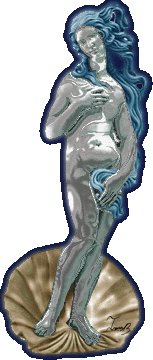 |
| Born to a poor tanner in the backstreets of Florence, Alessandro Filipepi was brought up by his brother who gave him the nickname botticelli, meaning �little barrel�.
The name stuck, and Botticelli's art became the most intelligent, creative and recognizable voice of the Florentine Renaissance. Only five years older than Lorenzo de'Medici, by the late 1460s Botticelli had made a name for himself under the apprenticeship of Filippo Lippi, an infamous Medici artist. The teenager was originally spotted by Piero il Gottoso and offered his own studio space inside the Medici Palace. He quickly befriended the charismatic heirs to the dynasty, Lorenzo and his brother Giuliano. Such intimacy with the most powerful family in Florence was critical to Botticelli's career. He didn't need to depend on his Medici friends for work. Their extended family and hangers-on fell over themselves to keep him busy. The most notorious example was the tax collector Guasparre dal Lama who, in an effort to impress the Medici, asked Botticelli to compose an �Adoration of the Magi�. The Medici had always fancied themselves as latter-day Magi, even sponsoring a city society to parade through the streets in celebration of the three wise men. The artist Gozzoli had already inserted the family into a �Procession of the Magi�, painted triumphantly in their private chapel. Now, Botticelli placed them right at the heart of the Nativity itself. Botticelli's painting celebrated Cosimo il Vecchio, Piero il Gottoso, Giuliano de'Medici and his brother Lorenzo, all gathered around the Holy Family. Surrounding them, were their closest friends and allies, scholars, politicians and businessmen. And, like Gozzoli's tribute, the painting also featured a self-portrait. Botticelli, staring arrogantly out at the viewer, placed himself inside the family's circle of friends. He was making a powerful statement to the world, and in a city as volatile as Florence, an alliance with the right family was crucial. Botticelli made his living, like any other artist, painting religious scenes, although his interest was far removed from Jesus. Behind the walls of the Medici Palace Botticelli listened to philosophical debates and classical legends, discussed amongst Lorenzo's intellectual friends. Botticelli was inspired, and under the protection of the Medici, he created an entirely new genre of art. "La Primavera� was neither portrait, icon nor holy celebration. It was pure fantasy, inspired by poetry, and fueled by a vivid imagination. This much-analyzed painting shows Venus, ancient goddess of beauty and fertility, celebrating the arrival of Spring, la Primavera. She is surrounded by allegorical figures representing the virtues and gods of the ancient world. It was a subject guaranteed to please Botticelli's protector, and no detail was overlooked. Even the laurel bushes behind Venus served to represent the rebirth of a golden age, under the patronage of Laurentius - Lorenzo - de'Medici. With such a sophisticated understanding of his friends' arcane ideas, Botticelli had successfully developed his own form of visual poetry, peppered with symbolism and private jokes. Inspired by Lorenzo's own classical sculptures, Botticelli later took his radical style to a new extreme, with a wedding present for Lorenzo's cousin, Lorenzo di Pierfrancesco de'Medici. The �Birth of Venus� was unlike any other painting of its time. Designed to be hung above the marital bed, it was a daring celebration of human desire. The painting was so controversial it was kept behind closed doors for half a century. Although Botticelli remained close to Lorenzo and was one of the friends who maintained a vigil at his death bed in 1492, Botticelli's own brother had become a disciple of the fiery Savonarola. After Lorenzo's death even Botticelli was swept along by religious fervor. His later paintings, such as the �Lamentation over the Dead Christ� reflected the apocalyptic themes of the sermons of Savonarola. Botticelli, fearing for his own everlasting salvation, even went so far as to hurl some of his own paintings onto the Bonfires of the Vanities. No one will ever know what masterpieces of the Renaisssance may have been lost forever to such zealous fundamentalism. |
| To the Medici page |


